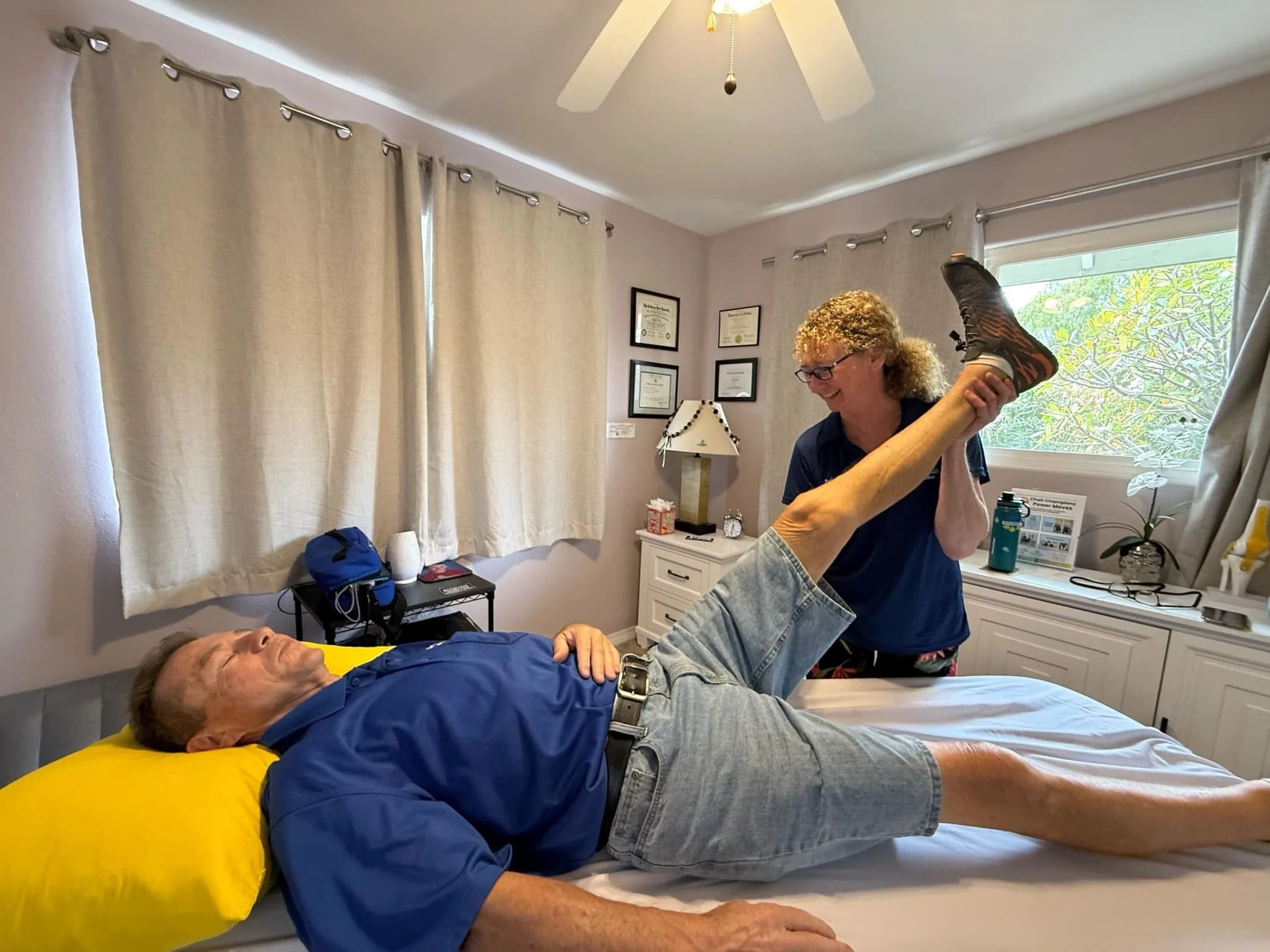ALL OTHER TECHNIQUES
AQUATIC THERAPY (IN-Home)
Exercises performed in water to reduce stress on joints and muscles, beneficial for conditions like arthritis and during post-operative rehabilitation.
BODY ED
Videos of self-care methods to get and keep your tissue healthy-watch them here on the website or on YouTube @TherapeuticConnection
ERGONOMICS ANALYSIS AND EDUCATION
Workstation Assessments, Proper Alignment Training at your desk, Preventative Exercise for Repetitive Strain Injury.
GOLF REHABILITATION AND INJURY PREVENTION
Golf Rehabilitation & Injury Prevention
Golf’s one-sided, high-impact motion increases injury risk.
Specialized techniques tailored to golfers' common injury patterns.
Improve mobility, strength, and swing efficiency while reducing pain.
HEALTH AND WELLNESS CONSULTATION
For Seniors who want to remain as active as possible!
INSTRUMENT-ASSISTED SOFT-TISSUE MOBILIZATION
Using a tool to accomplish reducing tension and restriction within your muscles and your fascia (the tissue that covers and runs within our muscles)
LUMBAR TRACTION
Mechanical Lumbar Traction
Relieves low back and lower extremity pain.
Gently stretches the spine to reduce compression.
Eases pressure from gravity and tight muscles on spinal joints.
MUSCLE ENERGY TECHNIQUES
Using your muscles through an isometric (no movement takes place) contraction to reposition a dysfunctional joint
MYOFASCIAL DECOMPRESSION™ / CUPPING
Myofascial Decompression™ (Cupping + Movement)
Relieves muscle and connective tissue restrictions.
Uses suction to lift and decompress fascia, easing tension.
Improves circulation, reduces inflammation, and promotes healing.
Helps with chronic pain, recovery, and mobility.
MYOFASCIAL RELEASE
Reducing tension and restriction within your muscles and your fascia (the tissue that covers and runs within our muscles) with direct manual/hands-on pressure to your tissues.
PELVIC HEALTH FOR WOMEN
Pelvic health is an essential—but often overlooked—part of a woman’s overall wellness. Whether you're dealing with pelvic pain, incontinence, core weakness, or postpartum recovery challenges, these issues are common but not normal, and you don’t have to live with them.
At Therapeutic Connection, I offer specialized, one-on-one pelvic health therapy that focuses on restoring strength, balance, and function to your core and pelvic floor in a safe, supportive environment. Through a personalized and holistic approach, we’ll work together to address your concerns and help you reconnect with your body from the inside out.
Pelvic health for men
Pelvic health isn’t just a women’s issue—men experience pelvic floor dysfunction too, and it often goes undiagnosed or misunderstood. Issues like pelvic pain, incontinence, post-prostatectomy complications, and core weakness can significantly affect quality of life.
At Therapeutic Connection, I provide specialized pelvic health therapy for men, using a discreet, one-on-one approach that addresses the root causes of dysfunction. Through targeted manual therapy, corrective exercises, and education, we’ll work together to restore strength, control, and confidence in your body.
Personal Training for Seniors (IN-HOME OR ONSITE)
Move Better, Feel Stronger, Live Fully
Aging isn’t a sentence to weakness, pain, or loss of independence. The truth is, your body is always capable of improvement—with the right approach.
At Therapeutic Connection, I offer personal training designed specifically for seniors who want to stay active, mobile, and pain-free. Whether you're concerned about balance, joint health, muscle loss, or bone density, my programs are tailored to support your body’s unique needs.
PERSONAL TRAINING (IN-HOME OR ONSITE)
Personal Training Tailored to You
Customized, holistic approach to fitness and wellness.
Detailed assessment to address your unique needs and goals.
Personalized plans with strength, flexibility, and cardio exercises.
Joint-friendly training to enhance mobility and prevent injury.
Expert one-on-one guidance for proper form and maximum results.
Focus on sustainable progress for long-term health and confidence.
POSTURAL RE-EDUCATION
Using verbal and tactile (hands-on) cues to facilitate improvement in your alignment reducing tension placed on your muscles and joints.
PROPRIOCEPTIVE NEUROMUSCULAR FACILITATION (PNF) CONTRACT-RELAX STRETCHING
Proprioceptive Neuromuscular Facilitation (PNF) is a rich and effective therapeutic approach that uses nerve impulses to recruit muscles through stimulation of the receptors in your muscles and tendons in addition to other sensory stimuli (tactile, visual or verbal). PNF is a hands-on technique that brings about improved strength, flexibility and greater motor control.
Contract-relax stretching is a component of PNF which uses a resisted muscle contraction while a musculotendinous structure is on stretch to facilitate improved range of motion and relaxation of a muscle that is shortened or restricted from adhesions, or sticky tissue.
SENIOR AQUATIC THERAPY
Aquatic Therapy is a safe and effective way for seniors to improve strength, balance, and mobility without the stress on joints that comes with land-based exercise. The water’s buoyancy supports your body, reducing pain and making movements easier while still providing resistance to build muscle and improve bone health.
At Therapeutic Connection, I offer personalized one-on-one aquatic therapy sessions designed to help you move comfortably, recover faster, and stay active with confidence.
SENIOR PHYSICAL THERAPY
Aging doesn't mean you have to accept pain, stiffness, or loss of independence. Senior Physical Therapy at Therapeutic Connection focuses on improving balance, strength, mobility, and joint health through gentle, personalized care.
Whether you’re recovering from an injury, managing arthritis, or looking to prevent falls, I’ll guide you with hands-on therapy and targeted exercises designed to keep you moving confidently and living life to the fullest.
SOFT TISSUE MOBILIZATION
Hands-on muscle release body work including several techniques including Myofascial Release, Strumming, Bending, Jones Compression, Cranio-sacral, Active Muscle Release.
TRIGGER POINT THERAPY
Soft tissue / myofascial restriction caused by restriction that lies in related body regions that refer pain
TMJ (TEMPOROMANDIBULAR JOINT) / JAW THERAPY
Therapeutic techniques unique to your jaw including external and internal Soft Tissue Mobilization or Massage and Joint Mobilization to improve range of motion or the opening of your mouth.
ULTRASOUND THERAPY
Utilizes sound waves to generate deep tissue heat, promoting healing in tissues like muscles, tendons, and ligaments.
VERTIGO/VESTIBULAR THERAPY
Whether your vertigo symptoms originate from an inner ear disturbance or a problem in your neck, there can be relief!












